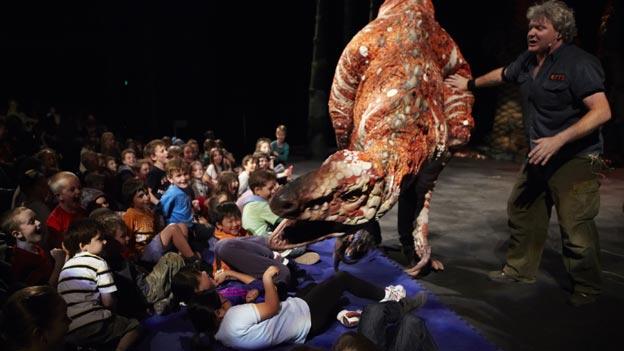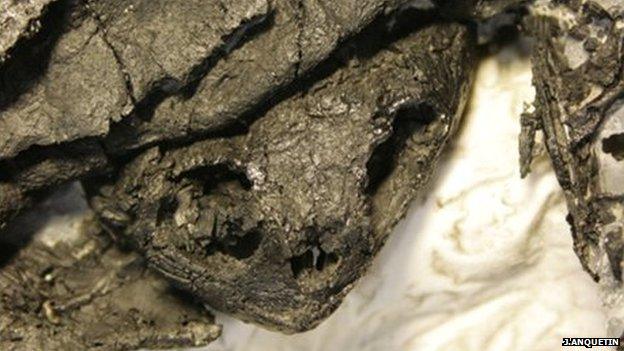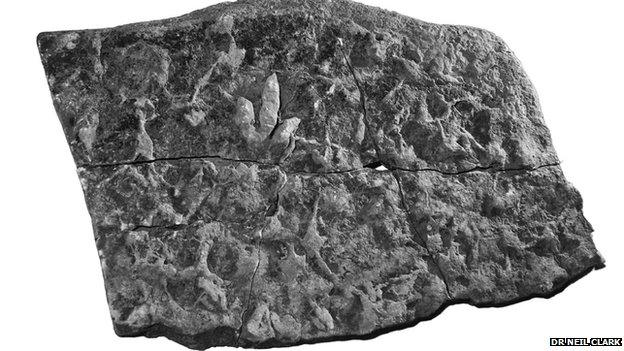Dino might: Delving into the Highlands' prehistoric past
- Published

The Dinosaur Zoo show will be taking to the stage in Inverness
Dinosaur Zoo, a new show from Australia, is headed for the Highlands, an area with a rich prehistoric past of its own and an unusual link to the fossil record of Down Under.
Dinosaur Zoo's cast of large-scale puppet creatures will be in Inverness next week when it takes the stage at the city's Eden Court.
Meat-eater Australovenator and the giant Titanosaur will be among the dinosaurs represented in the live show. Fossils of both beasts have been found in Australia.
But the rocks that make up the Highlands also hold clues to a menagerie of strange and ancient animals.
Fossils of fish that lived in a tropical lake 385 million years ago have been found in stone quarried at Achanarras in Caithness.
Called Lake Orcadie, those ancient warm waters' predators included the 50cm (20in)-long sharp toothed Glytolepis and also armour-plated Coccosteus.
Other early marine creatures - ammonites and bivalves - have been uncovered on the banks of the River Brora in Sutherland.

The earliest turtles known to live in water were discovered on Skye
Many fossil discoveries in the Highlands were made by Hugh Miller, a skilled stonemason and writer, who was born in Cromarty in 1802.
His study of fossils and rocks around his home on the Cromarty Firth has been credited with contributing to a greater understanding of the history of the Earth.
Miller made the first discovery of Pterichthyodes, a fish with distinctive box-like armour, at Achanarras. Pterichthyodes is thought to have been a bottom feeder that sought out food in the muddy shallows of Lake Orcadie.
Aquatic descendants
The Isle of Skye, however, is where some of the most exciting finds have been made.
In 2008, scientists revealed that the earliest turtles known to live in water had been discovered on the island.
The 164 million-year-old reptile fossils were found on a beach at Cladach a'Ghlinne, on the Strathaird peninsula in southern Skye.
The new species formed a missing link between ancient terrestrial turtles and their modern, aquatic descendants.
The discovery of Eileanchelys waldmani, which translates as "the turtle from the island", was reported in the Royal Society journals.

Dinosaur footprints have been found on Skye
Evidence of dinosaurs and ancient large reptiles from other periods have also been found on the island.
Many have been studied by Dr Neil Clark, of University of Glasgow's Hunterian Museum and Art Gallery, who has described Skye as one of the world's most important palaeontology sites.
The fossils include more than 100 marks left by a lizard called Isochirotherium - also known as the hand-beast - 270 million years ago.
Tippy toes
Skye also provides the Highlands with its link to Australia.
Palaeontologists have used dinosaur footprints found at Valtos to help explain what happened at the Dinosaur Stampede National Monument in central Queensland.
The monument is a former quarry where, since the 1960s, as many as 4,000 dinosaur footprints have been uncovered.
In 1984, the tracks were identified by scientists as being the result of small creatures fleeing from a larger animal, possibly a predator similar to the Tyrannosaurus rex, about 95 million years ago.
Others suggests the tracks were left by dinosaurs on their tippy toes as they waded through water.
New theories may follow in the future, and "walking" with dinosaurs on Skye might again help add weight to those fresh ideas.
- Published10 May 2013
- Published9 May 2013
- Published18 November 2011